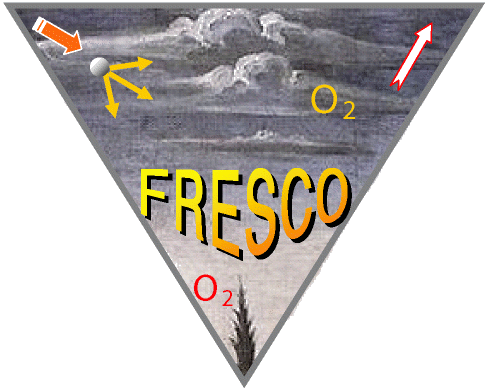
|
FRESCO cloud fraction & cloud top pressure -- algorithm |
 |
|||||||||||||||||
Tropospheric
|
|||||||||||||||||||
|
|
|
NO2
- global CH2O - global |
|
|
|
UV
- UV index - UV dose |
|
|
|
Ozone
- total column - global field - ozone hole - ozone profiles |
|
|
|
Aerosol
- ADRE - aerosol index Clouds - cloud info Surface - solar irradiance |
|
|
|
Volcanic plume
- SO2 & AAI |
|
|
|
Albedo
- climatologies Fluorescence - sun-induced |
16 December 2025
Clouds influence the depth of absorption lines of a trace gas in the spectrum, in particular if the trace gas concentration is high in the troposphere. For the retrieval of tropospheric trace gas columns it is therefore essential to have information on the cloud cover conditions. Both the cloud fraction and the cloud top pressure are needed as input for the trace gas retrieval algorithms. For the TEMIS project, the (effective) cloud fraction and cloud top pressure are derived with the algorithm called Fast Retrieval Scheme for Clouds from the Oxygen A band (FRESCO).
The FRESCO algorithm
The cloud top pressures and effective cloud fractions shown here are derived from calibrated level-1 reflectivity data of the GOME or SCIAMACHY spectrum of the oxygen A-band (between 758-775 nm). Three one-nanometer wide parts of the oxygen A-band spectrum are used in the FRESCO near-real time retrieval, both inside and outside the oxygen A-band, namely at 758 nm (no absorption), 761 nm (strong absorption), and 765 nm (moderate absorption).The reflectivity outside the oxygen A-band is almost independent of cloud top pressure, but depends mainly on cloud fraction, cloud optical thickness, and surface albedo. The reflectivities inside the band depend on cloud top pressure as well, and are used to derive cloud top pressure. An effective cloud fraction and cloud top pressure are derived for each GOME or SCIAMACHY pixel using non-linear least-squares fitting of a measured spectrum to a simulated spectrum.
The effective cloud fractions are derived by assuming that the clouds have an albedo of 0.8, and must therefore be interpreted as effective cloud fractions. Note that the derived cloud top pressures are rather insensitive to the assumed cloud albedo.
Notes
- For areas with effective cloud fractions smaller than 0.05, cloud top pressures cannot be derived reliably. These areas show up in blue in the effective cloud fraction and cloud top pressure maps.
- No attempt is made to account for the presence of snow, ice, or sun glint. Thus if cloud-free land or ocean is covered by snow or ice shelves, or if a pixel is affected by sun glint, these areas will show up as having low-altitude clouds with high cloud coverage.
Related subjects
- References:
- Koelemeijer, R. B. A., P. Stammes, J. W. Hovenier, and J. F. de Haan, "A fast method for retrieval of cloud parameters using oxygen A band measurements from the Global Ozone Monitoring Experiment", J. Geophys. Res. 106, 3475-3490, doi:10.1029/2000JD900657, 2001.
- Koelemeijer, R. B. A., P. Stammes, J. W. Hovenier, and J. F. de Haan, "Global distributions of effective cloud fraction and cloud top pressure derived from oxygen A band spectra measured by the Global Ozone Monitoring Experiment: Comparison to ISCCP data", J. Geophys. Res. 107, doi:10.1029/2001JD000840, 2002.